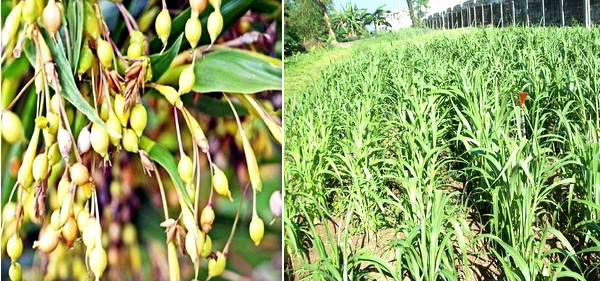A better appreciation of adlay as a traditional food staple in the country, alongside rice and corn, was set in motion in 2010, when the Bureau of Agricultural Research (BAR) of the Department of Agriculture (DA) developed a research and development (R&D) program to explore the potential of adlay.

Pioneering this initiative, BAR presented a breakthrough in adlay R&D in 2011 by establishing adaptability yield trials (AYT) in selected regions across the country. This was carried out through collaborative partnerships with various government and non-government organizations. In 2014 the AYTs were accomplished by all regions following full cropping cycles, generating significant results from cultivation, nutrient composition, to production and post-production management practices, which were central to the crop’s kickoff as another high value commodity.
What is adlay?
Unknown to many, adlay has been around for over centuries particularly in some parts of Southern and Eastern Asia. In the Philippines, it has been growing abundantly in the Zamboanga Peninsula. In fact, it is a staple food for the Subanens, a group of indigenous people in Zamboanga del Sur.
Adlay, scientifically known as Coix lacryma-jobi L., is an indigenous crop that comes from the family Poaceae or the grasses, where wheat, corn, and rice belong. It is often referred to as “Job’s Tears,” as its grains resemble a tear-like shape. A tall-grain bearing tropical plant, its stem grows from 3 to nearly 10 feet tall, with sword-shaped leaves. Grains are usually harvested 5-6 months after sowing, which can thrive for two cropping seasons both wet and dry
The AYT results show that adlay performs best in higher elevation but can also thrive in lower elevation preferably during the wet season. It can be planted as hedgerows and can also be intercropped with fruit trees and plantation crops such as coconut, banana, citrus, mango, and coffee. Although adlay is resistant to pest and diseases and can be grown as a pesticide-free crop, it responds well to organic fertilizers. Pulot, gulian, tapul, and ginampay are the four known local varieties of adlay.
Adlay R&D
Following the success of the yield trials, BAR has been supporting a total of 51 projects as of February 2015 under the adlay R&D program, which are implemented by the DA regional field offices, state universities and colleges, Philippine Center for Postharvest Development and Mechanization, and University of Asia and the Pacific (UA&P).
In the program’s effort to develop, promote, and utilize adlay to contribute to the country’s bid to achieve national food security, adlay seeds are being increased for production, processing, distribution, promotion, and further research. Furthermore, various production technologies were developed which include adlay production techno guides, improved management practices, and value-added products. Postharvest mechanizations were likewise developed including a modified rice-thresher for adlay, and a micro-milling machine.
Another noteworthy accomplishment under the adlay R&D program is the rise of adlay champion products from the regions. Gourmix, developed by researchers in the Cagayan Valley Research Center (CVRC) in Ilagan, Isabela, is a health food made up of adlay grits, turmeric, ginger, malunggay powder, ground mungbean, soybean, white corn grits, and rice. Currently, Gourmix is being used in various feeding programs of public and private groups. Other well-known adlay products include adlay breakfast cereal, wine, polvoron, puto, champorado, and coffee, among others.
With these already available products, BAR commissioned UA&P to conduct a market research for adlay to determine its acceptability in the market, design appropriate product development, and come up with a marketing plan both for adlay grains and processed products. The highlights of the results consist of a high percentage on the potential buyers of adlay which can be over 80 percent despite of its low public awareness. Also, adlay got a positive nod from the respondents in terms of its processed products such as the adlay breakfast cereal and Gourmix, underlining its nutritive properties. According to a chemical analysis released by Food and Nutrition Research Institute (FNRI) in 2011, adlay is superior in terms of its food energy content (365 kcal), carbohydrate content (73.9 g), protein (12.8 g), and fat (1.0 g) compared to rice and corn.
At present, the adlay R&D program is continuously working towards the expansion of production heeding its commitment to stabilize food supply and market prices. Revealing its numerous potentials through R&D, BAR hopes to encourage and sustain productivity while ensuring a self-sufficient, healthy staple food for all Filipinos. ### (Daryl Lou A. Battad)
Source: bar.gov.ph
